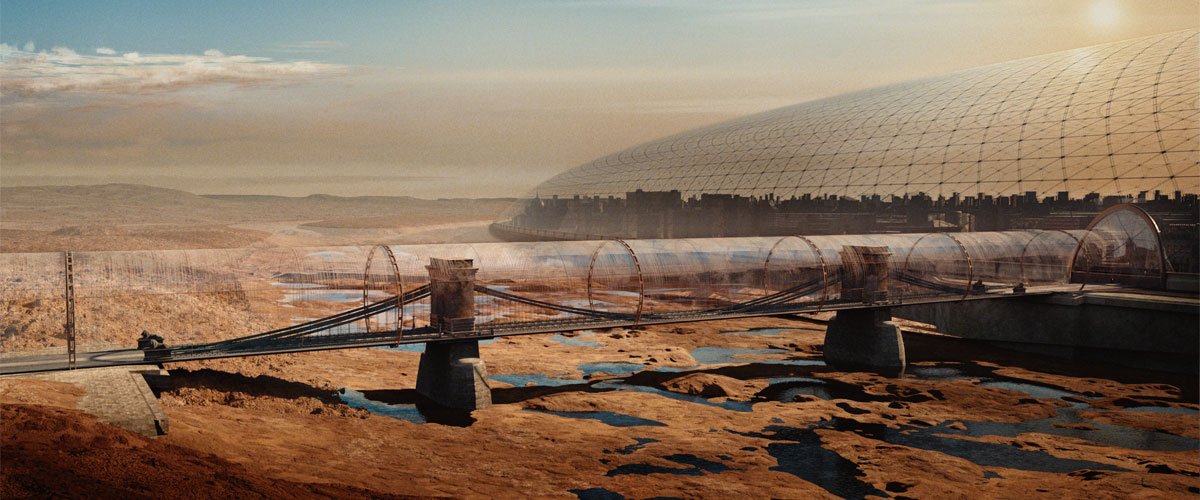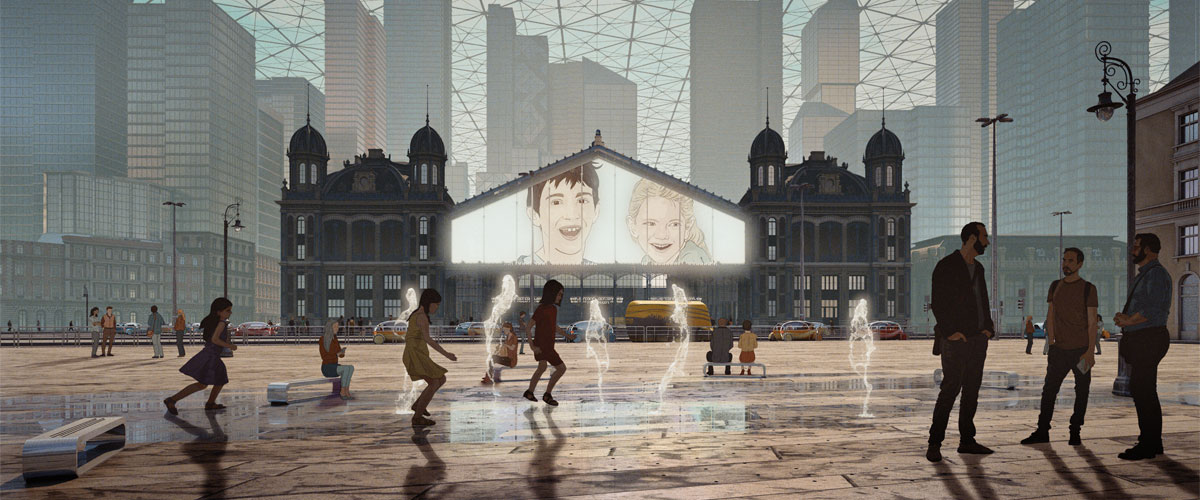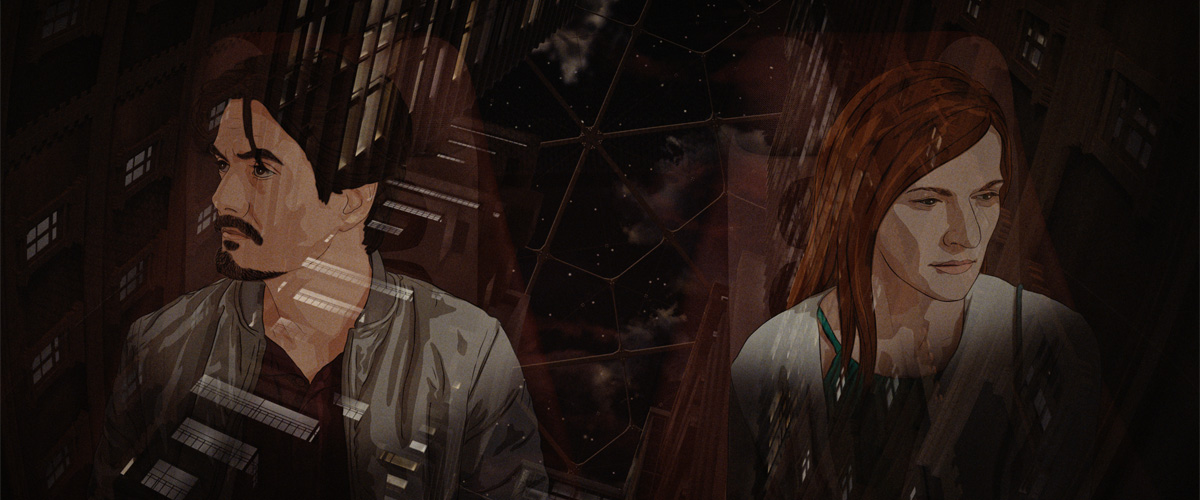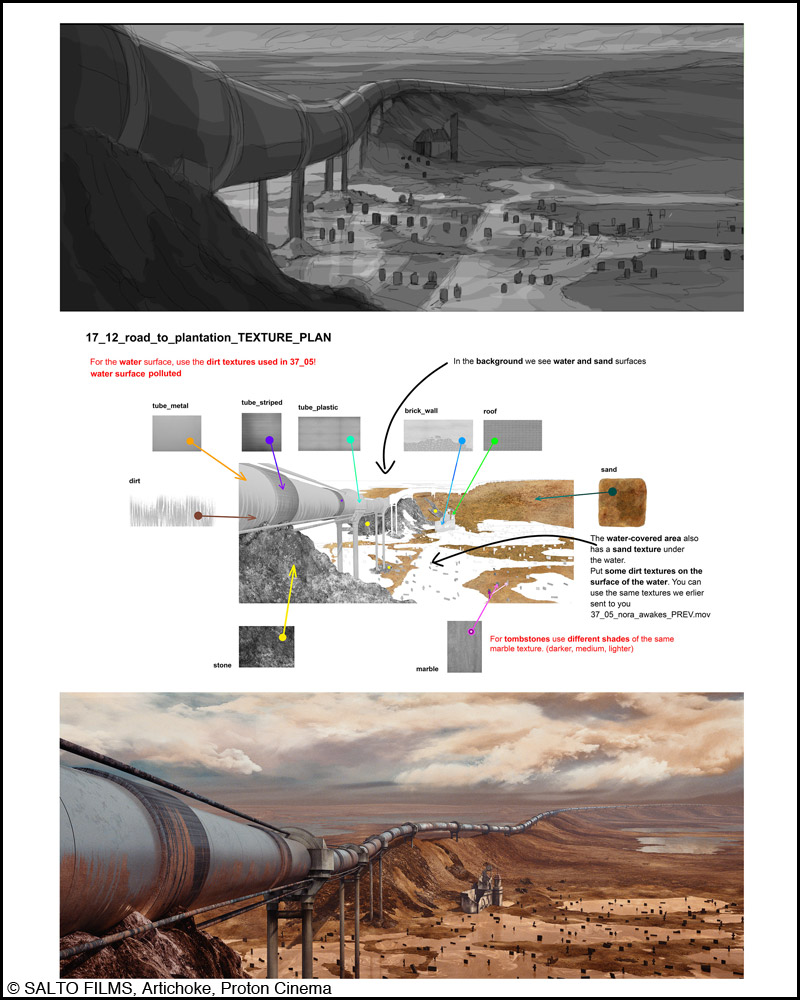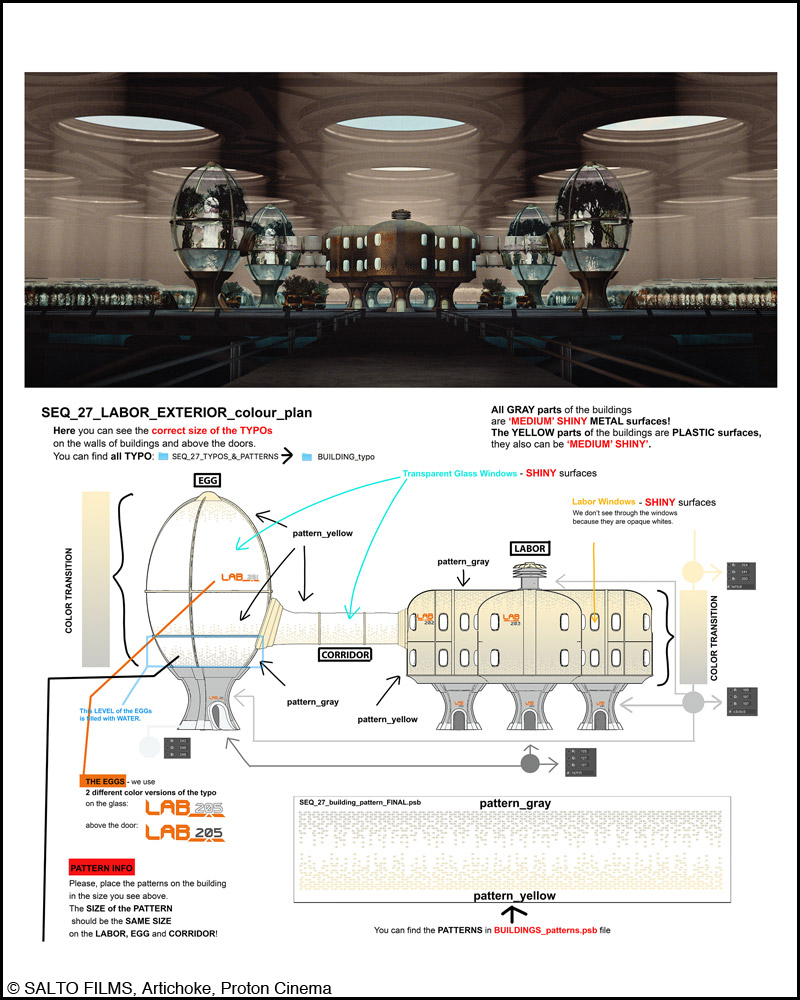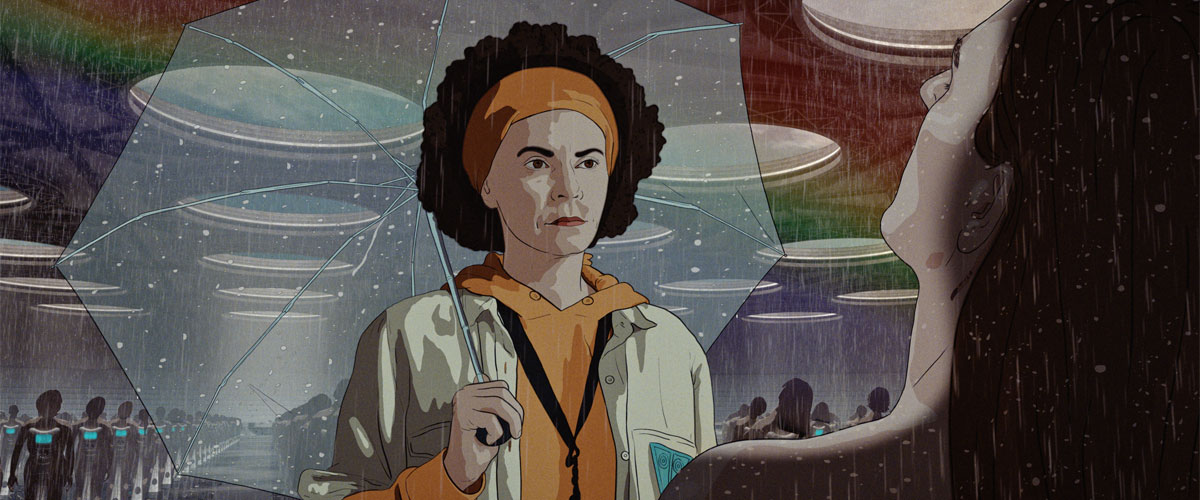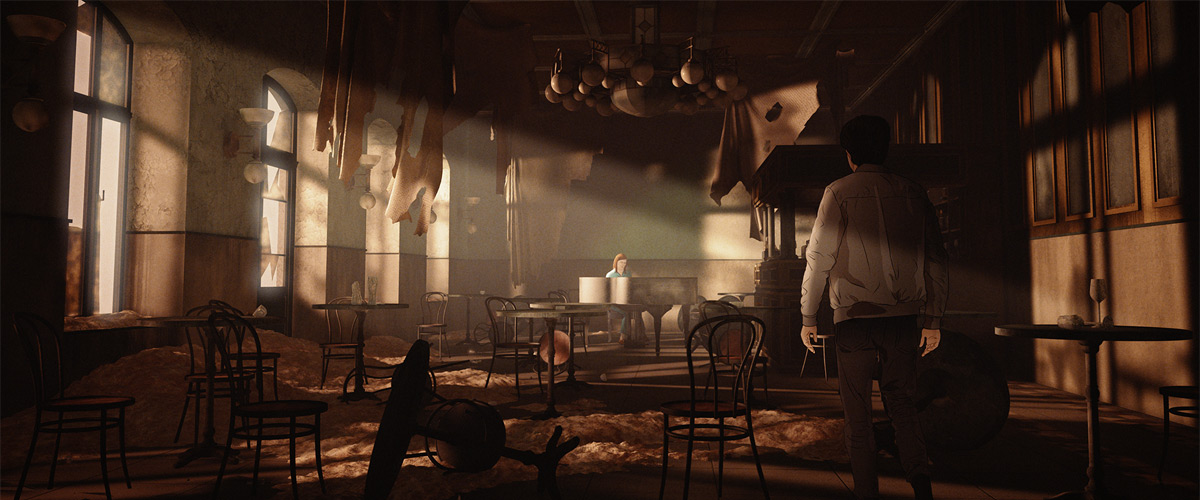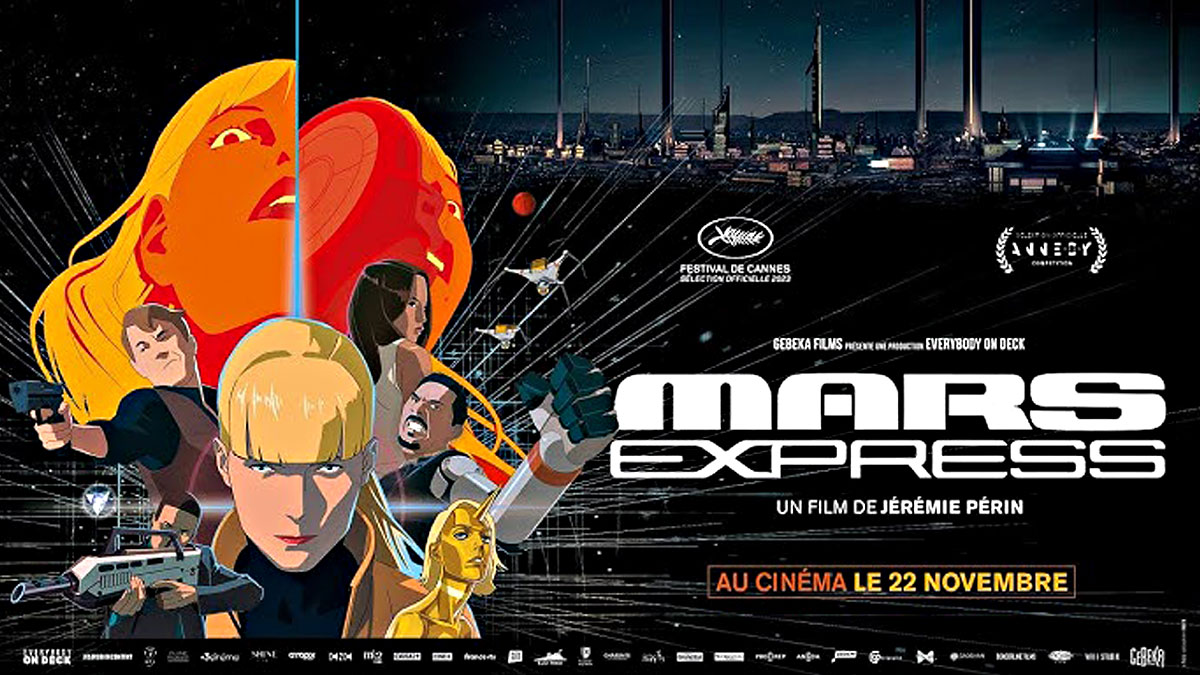Synopsis
2123. Faced with diminishing resources, the human race can only survive through a trade-off: at the age of 50, every citizen is gradually turned into a tree. When Stefan discovers that his beloved wife Nora has voluntarily signed up for donating her own body before her time, he sets out on an adventurous journey to save her at all costs.
Film credits
Directors: Tibor Bánóczki and Sarolta Szabó
Scriptwriters: Tibor Bánóczki and Sarolta Szabó
Music: Christopher White
Producers: Orsolya Sipos (SALTO FILMS, Hungary), József Fülöp (SALTO FILMS, Hungary), and Juraj Krasnohorsky (Artichoke, Slovakia)
Co-producer: Viktória Petrányi (Proton Cinema, Hungary)
Target audience: Adults / Young adults
Technique: Rotoscoping / 3D digital
Running time: 112 minutes
White Plastic Sky is a Sci-Fi romance film set in a post-apocalyptic Earth facing ecological extinction. A grim look at our possible future for humanity, the story is told from the point of view of one couple.
Although a confronting film on the tragedies of the future of humanity, what you take away from the film may not be feelings of despair or sadness. The film could be a journey for you to consider the meaning of the lives of you and your loved ones, and the meaning in the sustainability of human society for Earth.
The film was selected for Encounters at Berlinale 2023 and is nominated for Feature Films Contrechamp in Competition at Annecy 2023.
We interviewed Tibor Bánóczki and Sarolta Szabó, the co-directors and co-scriptwriters of the film.
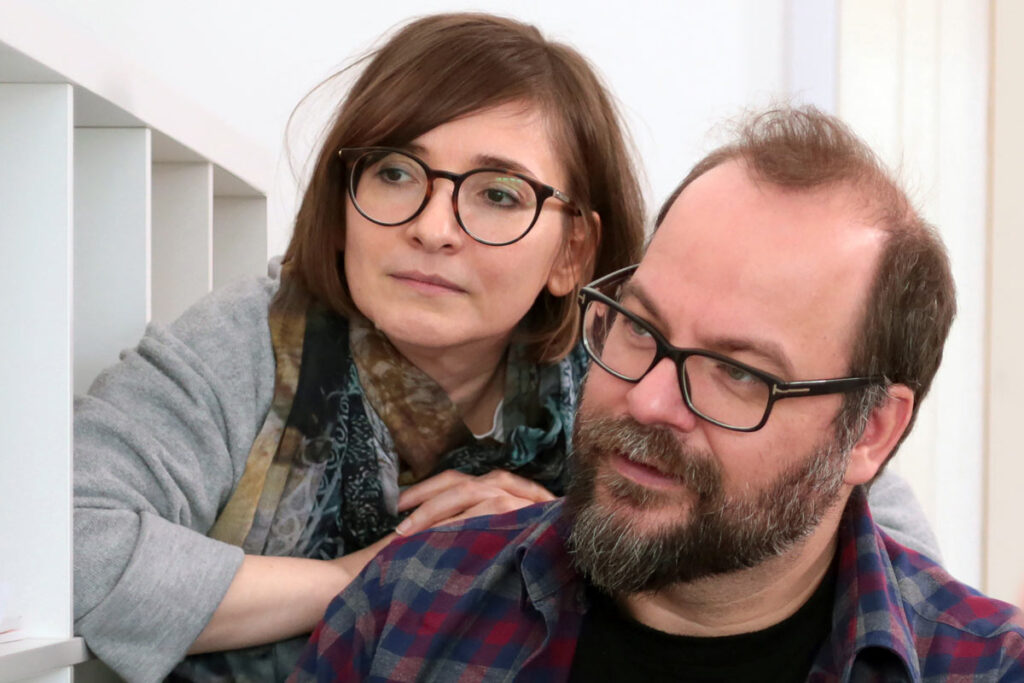
Interview with Tibor Bánóczki and Sarolta Szabó
Hideki Nagaishi (HN): Could you please let us know what do you most want to deliver to the audience through the film, and what do you want the audience to take away from this film?
Tibor Bánóczki: Our core idea was the question of value of life on Earth, whether the life form of homosapiens is the most superior of them all? What if our main purpose in the future will be to preserve any kind of life on this planet, pushing ourselves and our human existence/survival into the background?
Sarolta Szabó: We also wanted to discover the paradox of sacrifice; Whether humanity is able to choose between the bigger issues and between family and love matters. Is it possible to sacrifice ourselves, our children, our love to the greater good? These are the most important questions of humankind and we wanted to explore that through our characters’ story.
HN: Where did the initial idea of the story and characters come from? And what made you take the final decision to make an animated feature with that story?
Tibor Bánóczki: An ancient motive, the metamorphosis has met the issues of climate change.
Beside philosophical questions, the poetry in metamorphosis offered a great motive for love. Through the long lifespan of trees we could offer our main characters something they wouldn’t be able to live as human beings: seemingly endless love. It was important for us to examine this idea and to think about the possibility that other life forms are capable of this emotion too. Animation was an obvious choice, we could see our story in this medium right from the beginning.
HN: What did you take care in the most when you developed the story and what was the most difficult part of the story to make for you?
Sarolta Szabó: We wanted to create a fine balance between the relationship drama and the dystopian world. This is first and foremost a love story, a story of grieving, a story of reinventing love and finding eternity in love. Our main concept was already dystopian enough since the beginning, so actually it was the world which moved closer to our movie. Sarcastically we could call ourselves lucky that our source material did not age throughout the years of the production, but one could say that’s quite sad.
Perhaps the most frightening was how recent history has filled with new meanings some of the scenes we have created beforehand. For example the childrens toy tank become some kind of metaphor of the Ukrainian war. The toy tank was in our scene long before the war broke out but sadly became a more menacing image than we could ever imagined.
HN: Humans on Earth are about to face extinction in the film. How and why did you decide to tell that global-scale story by focusing on the point of view of a couple in Budapest, Hungary, without depicting rest of the world?
Tibor Bánóczki: When we decided to make Budapest and Hungary the centre place of our story, we felt we have ‘settled the story itself’. We felt home. It was very tempting to invent and explore the future history of Budapest and Hungary. The destruction of the country has brought many resonance with our current political issues. In our film, Budapest isolates itself from the rest of the world. We can see this in our current foreign policy. So, we can say a dome can be built over a country invisibly. We also thought a lot about what could happen if our government announces the 50-year life span. Would us Hungarians go onto the streets to demonstrate, or just accept it silently?
HN: The story setting and visual design of all the things with future technologies are detailed and made the film feel grounded in reality. I think you did a lot of scientific research for that. Could you please let us know what research you did and how?
Sarolta Szabó: For the environment point of view, we have discussed with several scientists how the climate and the weather would behave in such catastrophic circumstances. We have also discussed with architects about the possibilities of building materials of an isolated city which has no connection with the rest of the world. Using the animation medium could be limitless in designing a futuristic city, but we did not want to create a very sci-fi look as we thought it would go against our love story. The human relationship is the heart of the story, the design has to be built around that, not the other way around. A heavy sci-fi design would disorient and divert the focus from our characters.
We wanted the audience to connect easily with the landscape, to be familiar with the world where the film takes place. That is why many locations are painfully similar to today’s Budapest and Hungary, and many real places and buildings that exist today also appear in the film.

HN: As the character animation of the film was developed with rotoscoping, I think you shot all the scenes of the film with real actors beforehand. And the background art of the film was made by 3DCGI with realistic textures. So, I think it was also possible for you to make a live-action film. Could you please let me know the reason why you selected animation as the visual storytelling medium for this film?
Tibor Bánóczki: It would never be possible for us to make this story a live action sci-fi film with the circumstances we were working in. Although White Plastic Sky is an extremely low budget film, we could imagine and managed to create any scenes we wanted. From the very beginning we knew that this story and this genre needs a certain production quality to reach its audience and although we worked with a small crew, with a lot of work and enthusiasm we managed to produce a high production value. Using a mixed animation technique and rotoscope felt a good match for the film’s theme conceptually. Exploring different life forms, White Plastic Sky is also a hybrid itself, existing between animation and live action films.
HN: Could you please let us know the story behind the music composition for the film?
Sarolta Szabó: We have been working with Christopher White for 15 years now (Christopher White was a fellow composer student of Tibor at the NFTS). We always start our collaboration with him on the earliest stages of the animatic. The music scores go through many phases as the movie evolves throughout the years. We also try different feelings until we catches the final mood. Christopher understands the length of an animation production perfectly and he is an amazing creative partner.
An animated film exists in a sketch format for a long time, which means scenes are very far from finished and they are changing all the time. You see the colourless layout backgrounds and unanimated scenes for years and as a composer you have to imagine them beforehand and write a score for them. For this you need a lot of imagination and a great sense of visuality.
Most of the time, we approached the music from the emotional side, we have talked a lot about what is the purpose of the scene, what happens with the characters emotionally, and what the audience should feel.
HN: What are some of the influences or works you were aware of when making this film? And what do you think makes your film stand out from those works, considering your inherit tastes and individualities as creators?
Tibor Bánóczki: In dystopian films humanity always saves itself one way or another. We wanted to create a very different ending, and maybe that which makes our film different. High concept sci-fi films always refer or rather forecast problems and crises of the world and undeniably share some common motives which directors wants to unwrap from time-to-time. Although films like Soylent Green or Logan’s Run deal have some similar motives as White Plastic Sky, the problem of food producing, ageing, etc., the core concept and the central questions are different in each of these films and we believe the philosophy and the outcome of White Plastic Sky is a standout.
Sarolta Szabó: It was clear for us from the very beginning of the development that we want to give an uncomfortable ending for the audience. We wanted to show very different choices in this dystopian world. They can sympathize or they can reject the characters’ solutions and answers. Is it the right decision what our main couple do at the end of our film? Maybe yes, maybe no. But this is the choice which can stimulate us to think further what can or should we do on this planet. In the uncertain world we live in today, as filmmakers we felt that we should not force any answer on anyone. That is the job the audience has to do.


